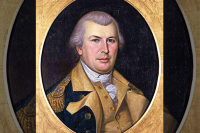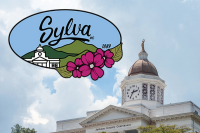The evocative power of the color blue
 Green used to be the color that caught my eye. Now it’s blue. So much so that I wrote an ode (of sorts) to the color blue that is in my book Permanent Camp. It goes like this:
Green used to be the color that caught my eye. Now it’s blue. So much so that I wrote an ode (of sorts) to the color blue that is in my book Permanent Camp. It goes like this:
SAY BLUE
Say the word blue
until it sounds strange to you
the way words do when repeated.
Blue starlight.
Blue gentians.
Related Items
Blue eyes.
Water greenish blue.
Snowflakes bluish white.
Shadows gray blue.
Jay on a bare limb
ruffles his feathers
and screams: “Blue!”
Rows of silent blue ridges
move ever closer in the
winter light.
Howling low
blue wind’s blowing
your troubles away.
Say the word blue.
It is a strange word.
Say it over & over.
According to an online dictionary, the word blue comes from Middle English, bleu or blwe, which came from an Old French word for “shining.” Many languages do not recognize separate colors for blue or green, using a cover term for both. In English this can be rendered as “grue.”
Blue is the color of light between violet and green: turquoise, teal and aquamarine; as well as, of course, pure blue. The lighter shades of pure blue … sky blue and azure … are white tinted. And sky blue can be either lighter or darker in hue. I prefer the lighter but the darker will do.
The rock band Wilco’s first album was titled “Sky Blue Sky.” The opening lines of the closing stanza of the title song read: “With a sky blue sky / This rotten time / Wouldn’t seem so bad.” We can all identify with that from time to time. Just seeing something blue will make you feel better.
There are wondrous shades of blue displayed by Appalachian wildflowers, ranging from the electric shimmer of some hepaticas in early spring to the velvety tall bellflower in mid-summer to the gentians in fall. But none of our wildflowers display an ethereal blue that can rival chicory. Writer-naturalist Edwin Way Teal penned this tribute in one of his notebooks: “On this day, I drive to Concord, Massachusetts, for the annual Thoreau Society meetings tomorrow. Along the way, I see that most beautiful of blues, the tint of the wild chicory in bloom. It seems to me the most perfect blue on earth, the most perfect blue under the sky.”
George Ellison wrote the biographical introductions for the reissues of two Appalachian classics: Horace Kephart’s Our Southern Highlanders and James Mooney’s History, Myths, and Sacred Formulas of the Cherokees. In June 2005, a selection of his Back Then columns was published by The History Press in Charleston as Mountain Passages: Natural and Cultural History of Western North Carolina and the Great Smoky Mountains. Readers can contact him at P.O. Box 1262, Bryson City, N.C., 28713, or at This email address is being protected from spambots. You need JavaScript enabled to view it..









